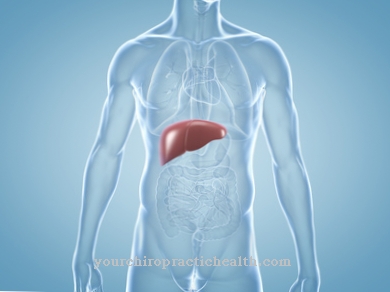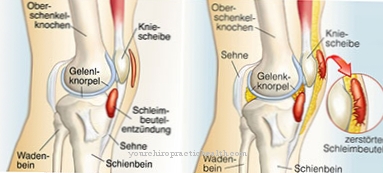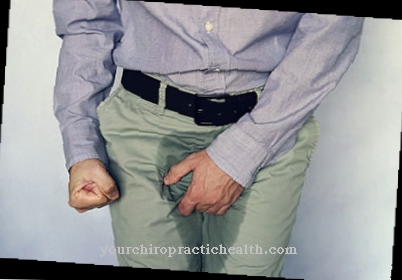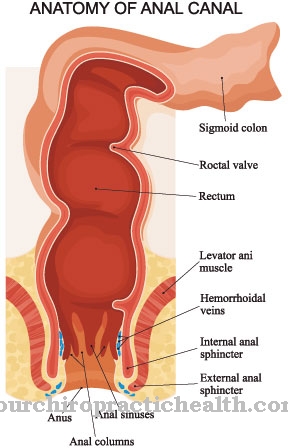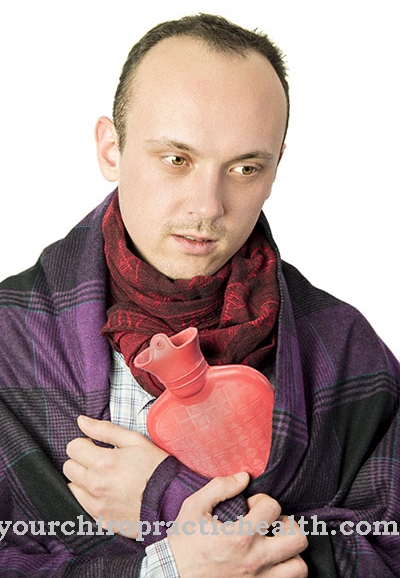A Fat embolism is an embolism caused by fat droplets in the bloodstream. Acute pulmonary embolism usually develops as a result of the obstruction of a vessel by the fat droplets.
What is a fat embolism?

© anaumenko - stock.adobe.com
The term embolism describes the complete or partial occlusion of a blood vessel by various substances and substances. In fat embolism, fat droplets enter the vessels via the blood. These are either released tissue fats or precipitated plasma fats.
Plasma fats are also called lipoproteins. Lipoproteins are aggregates of proteins and fats. They are used to transport water-insoluble fats and cholesterol. The envelope and the contents of the lipoproteins are susceptible to oxidation and thus also to vascular deposits. When drops of fat come off, they enter the narrow capillaries via the blood system and get stuck there. Most often, the fat embolism ends in the blood vessels of the lungs.
A pulmonary embolism develops, with symptoms such as shortness of breath and chest pain. If the embolus enters the arterial blood system, the fat droplets can cause a heart attack, stroke, or kidney infarction. In some cases, the fat embolism occurs together with the fat embolism syndrome.
causes
A fat embolism usually occurs after bone fractures. The bone marrow also consists of fat. If the bone marrow was damaged when it was broken, fat can leak out of the bone marrow's reticulum cells and enter the bloodstream. After fractures of long tubular bones, intramedullary nailing and fractures of several rib bones, almost 90 percent of patients have very small fat embolisms in the lungs.
Even after blunt trauma to adipose tissue or fatty liver, fat droplets get into the lungs. It can take up to four days for the small fat molecules to reach the vessels of the lungs. A fat embolism can also be the result of mechanical body fat reduction, a so-called liposuction. Burns, rhabdomyolysis, bone marrow transplants, and bone marrow harvesting can also cause fat embolism.
Various diseases are also frequently associated with fat embolism. These include acute pancreatitis, obesity, sickle cell anemia, diabetes mellitus, viral hepatitis, muscular dystrophy, myocardial infarction and systemic lupus erythematosus. Exogenous risk factors include tube feeding, propofol infusions, high-dose steroids, lymphography, and high-dose chemotherapy.
Symptoms, ailments & signs
The symptoms of a fat embolism are often uncharacteristic. The affected patients complain of shortness of breath. Breathing is accelerated. The heart is racing and the patients have chest pain. These can also radiate to the shoulder, back or stomach. The pain is accompanied by fear and restlessness. Patients may have to cough.
If blood vessels burst from the increased pressure in the lungs, the sputum may be mixed with blood. Patients sweat profusely and complain of dizziness. Eventually they may faint. In some cases, cardiac arrhythmias also occur. If large blood vessels are affected by the fat embolism or if a large part of the lungs is no longer supplied with blood, there is a risk of a circulatory collapse and shock.
Many of the patients with fat embolism have slowed blood flow and increased blood viscosity. The vascular damage caused by the fat droplets activates blood clotting. The activated platelets release serotonin. This increases the permeability of the small blood vessels. Fluid leaks into the tissue so that a shock can occur within a few hours.
Before a large or several drops of fat clog the vessels of the lungs, smaller embolisms can occur. These manifest themselves as mild chest pain, coughing or dizziness. Small fat embolisms can still be broken down by the body so that the symptoms disappear again after a short time. A fat embolism syndrome can develop as part of a fat embolism.
It is characterized by the triad of petechiae, neurological symptoms, and respiratory symptoms, and occurs 12 to 36 hours after trauma with fat embolism.
diagnosis
The findings of fat embolism are often unspecific. In some cases, the main criteria such as shortness of breath, rapid breathing or pain in the thoracic area are completely absent, so that fat embolism is often a diagnosis of exclusion. Blood and urine tests may contain fat droplets, indicating a fat embolism.
Whether fat-containing phagocytes in the bronchiolo-alvelar lavage are really always an indication of a fat embolism of the lungs is still being discussed. A chest x-ray may provide additional evidence of a fat embolism.
In the case of a pronounced embolism, spot-shaped infiltrates can be seen in the upper areas of the lungs. Arterial blood gas analysis can also provide clues. An insufficient supply of oxygen (hypoxia) is often one of the early symptoms of fat embolism. Thrombocytopenia can be detected in a third of patients. Unexplained anemia is described in two thirds.
Since both thrombocytopenia and anemia are not specific and the mechanism has not yet been clarified, they can also be viewed as rather uncertain evidence. Biochemical tests are not specific enough either. Serum lipase and phospholipase are increased in the case of lung damage caused by a fat embolism, but they are also increased in trauma patients without a fat embolism.
Complications
A fat embolism can cause serious complications. One of these is a pulmonary embolism, which in the worst case can lead to death. Since pulmonary embolism occurs mainly acutely, a quick rescue by an emergency doctor is necessary so that the patient survives. In most cases, those affected experience difficulty breathing.
Breathing occurs in the chest and the heart beats faster. Often the patients suffer from panic attacks and severe dizziness. The pain in the lungs and heart leads to anxiety and fear of a heart attack. The rapid palpitation of the heart also leads to outbreaks of sweat, and some people affected lose consciousness and faint.
Due to the fat embolism, the patient is severely restricted in his everyday life. Even simple and easy movements seem exhausting and can lead to pain in the lungs or heart. Targeted treatment is not possible. However, free fatty acids can be bound by albumins, which can reduce the symptoms of fat embolism. However, the complications and complaints described above can also occur here.
When should you see a doctor?
In the event of shortness of breath, palpitations or other signs of a fat embolism, a doctor should be consulted immediately. Chest pain and coughing attacks are also warning signs that need to be clarified quickly. If other symptoms such as sweating, dizziness or signs of a cardiac arrhythmia occur, it is best to call an emergency doctor.
In the event of a circulatory collapse with shock, the person affected must also be treated immediately by a doctor. The body can usually break down small fat embolisms on its own. A medical examination is necessary if symptoms such as coughing, dizziness or mild chest pain occur again and again.
If symptoms of fat embolism syndrome occur, this must be investigated immediately and treated if necessary. The family doctor can make a first guess and then refer the patient to a specialist who will initiate further therapeutic measures.
Regular visits to the doctor are required during treatment to rule out complications. However, should undesirable events occur, the emergency medical service can be contacted. If the symptoms are severe, the patient should be taken to hospital.
Doctors & therapists in your area
Treatment & Therapy
Since the pathogenesis of fat embolism has not yet been fully understood, there is no standard of therapy. The administration of corticosteroids has a favorable influence on the prognosis of fat embolism. Albumins can bind the free fatty acids and thus have a positive effect. Heparin can also clear the blood plasma from lipids.
Outlook & forecast
The fat embolism is an acute health condition. Without medical care or the immediate implementation of first aid measures, the affected person can die prematurely. With rapid intensive medical care and subsequent good medical care, the symptoms can be alleviated. Freedom from symptoms can also be obtained.
However, depending on the intensity of the symptoms caused by the fat embolism, it can also lead to lifelong impairments. Long-term therapies are offered, which should lead to a constant improvement in the quality of life. With the cooperation of the patient, there is a good chance of reducing the symptoms. The overall lifestyle must be adapted to the patient's options after experiencing the emergency situation. In addition, the causes of the fat embolism must be healed and cured in parallel. This is usually given within a few months.
Since broken bones or damage are among the most common causes of fat embolism, this healing prospect must be considered individually. If, in addition to the physical symptoms, the shortness of breath or the experience of the traumatizing condition develop further mental illnesses, the prognosis worsens. The psychological complications can lead to a severe reduction in the quality of life and have a detrimental effect on various lifestyles. In severe cases, the patient will suffer from the experiences until the end of his life and develop psychosomatic disorders.
prevention
In order to prevent the development of fat embolisms during operations after fractures, the pressure on the bone marrow should be kept as low as possible during the operation. This can be achieved with a vacuum procedure or with an external fixator.
Aftercare
Follow-up care options are severely limited in the case of fat embolism. A radical change in diet should take place in order to prevent the further formation of fat droplets. As a rule, a doctor can set a correct and healthy nutrition plan, according to which the person concerned can orient himself.
The fat embolism may also limit the patient's life expectancy. After successfully treating the disease, it is important to follow a healthy lifestyle with a healthy diet so that the disease does not recur.
Various sports can also be helpful in relieving the symptoms and increasing the body's performance again. In many cases, those affected are dependent on taking medication to permanently alleviate the symptoms. It is important to ensure that it is taken regularly and that the dosage is correct, so that there are no further complications.
First and foremost, however, the trigger of the fat embolism should be identified so that the cause can be treated quickly. In the case of psychological upset or depression, the help and support from your own family has a very positive effect on the further course of the disease.
You can do that yourself
A fat embolism often occurs after a fracture of myelinated bones or after orthopedic or trauma surgery. Blunt injuries to the liver also carry the risk of fat embolism. But many diseases such as pancreatitis, myocardial infarction or viral hepatitis can also cause an acute fat embolism. As a rule, these are acute cases that require immediate emergency medical care.
Self-help measures are not considered in acute fat embolism. Even in less severe cases, there is usually pain in the lungs, and those affected often experience panic attacks, feelings of anxiety, and sweats, or even faint. Therapeutic measures usually consist of a strong supply of oxygen to compensate for the reduced lung function.
At the same time, intensive medical care and treatment are indicated in order to be able to intervene immediately if serious complications are imminent. Usually catecholamines are used, which are administered under strict control of pulmonary arterial blood pressure. Because of the acute emergency situation, there is no need to make adjustments in everyday life.
Because of the often unspecific symptoms associated with weakly progressing fat embolisms, a clear diagnosis is often difficult, especially if there is neither shortness of breath and high breathing rate nor pain in the chest area.


